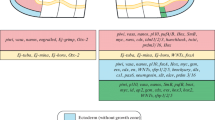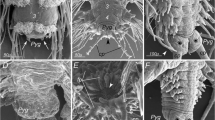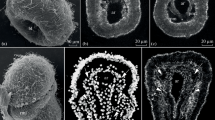Abstract
The biphasic life cycle in annelids is characterized by two completely different types of organisation, i.e. the acoelomate/pseudocoelomate larva and the coelomate adult. Based on this observation the recent literature on the different assumptions on the organisation of the bilaterian stem species with special emphasis on the evolution of the annelid body plan is reviewed. The structure of the coelomic lining ranges between a simple myoepithelium composed of epithelio-muscle cells and a non-muscular peritoneum that covers the body wall muscles. The direction of the evolution of these linings is discussed with respect to coelomogenesis. As the coelom originates from mesodermal cell bands, different assumption on the acoelomate condition in Bilateria can be substantiated. The origin of segmentation in annelids is explained by current hypothesis. Although no final decision can be made concerning the origin of the annelid body plan and the organisation of the bilaterian stem species, this paper elaborates those questions that need to be resolved to unravel the relation between the different body plans.
Similar content being viewed by others
References
A. Adoutte G. Balavoine N. Lartillot R. de Rosa (1999) ArticleTitleAnimal evolution the end of the intermediate taxa Trends in Genetics 15 105–108 Occurrence Handle10.1016/S0168-9525(98)01671-0
A. Adoutte G. Balavoine N. Lartillot O. Lespinet B. Prud’homme R. de Rosa (2000) ArticleTitleThe new animal phylogeny: reliability and implications Proceedings of the National Academy of Sciences, USA 97 4453–4456 Occurrence Handle10.1073/pnas.97.9.4453 Occurrence Handle1:CAS:528:DC%2BD3cXivFKjs7Y%3D
Anderson, D. T., 1973. Embryology and Phylogeny in Annelids and Arthropods. Pergamon, Oxford, 495 pp.
Ax, P., 1996. Multicellular Aminals. A New Approach to the Phylogenetic Order in Nature. Springer, Berlin, Heidelberg, New York, 225 pp.
G. Balavoine (1998) ArticleTitleAre Platyhelminthes coelomates without a coelom An argument based on the evolution of Hox genes. American Zoologist 38 843–858 Occurrence Handle1:CAS:528:DyaK1MXhtVeisrc%3D
T. Bartolomaeus (1994) ArticleTitleOn the ultrastructure of the coelomic lining in Annelida, Echiura and Sipuncula Microfauna Marina 9 171–220
G. E. Budd (2001) ArticleTitleWhy are arthropods segmented Evolution and Development 3 332–342 Occurrence Handle10.1046/j.1525-142X.2001.01041.x Occurrence Handle11710765 Occurrence Handle1:STN:280:DC%2BD3MnmsVaitQ%3D%3D
Clark, R. B., 1964. Dynamics in Metazoan Evolution. The Origin of the Coelom and Segments. Clarendon, Oxford, 313 pp.
R. B. Clark (1964) Dynamics in Metazoan Evolution The Origin of the Coelom and Segments. Clarendon Oxford 313
E. H. Davidson K. J. Peterson R. A. Cameron (1995) ArticleTitleOrigin of adult bilaterian body plans: evolution of developmental regulatory mechanisms Science 270 1319–1325 Occurrence Handle7481819 Occurrence Handle1:CAS:528:DyaK2MXpsFOhurY%3D
G. K. Davis N. H. Patel (1999) ArticleTitleThe origin and evolution of segmentation Trends in Genetics 15 M68–M72 Occurrence Handle10.1016/S0168-9525(99)01875-2 Occurrence Handle1:CAS:528:DC%2BD3cXpvFGg
D. W. Fawcett (1994) A Textbook of Histology Chapman & Hall New York 964
M. E. Fransen (1980) ArticleTitleUltrastructure of the coelomic organisation I. Archiannelids and other small polychaetes. Zoomorphologie 95 235–249
M. E. Fransen (1982) The role of ECM in the development of invertebrates: a phylogeneticist’s view S. Hawkes J. L. Wang (Eds) Extracellular Matrix 478 Academic New York 177–181
Fransen, M., 1988. Coelomic and vascular system. In Westheide W. & C. O. Hermans (eds), The Ultrastructure of Polychaeta. Microfauna Marina 4: 199–213.
S. L. Gardiner (1992) Polychaeta.General organization, integument, musculature, coelom, and vascular system F. W. Harrison S. L. Gardiner (Eds) Microscopic Anatomy of Invertebrates Vol.7 Annelida. Wiley-Liss New York 19–52
Garey, J. R., 2003. Ecdysozoa: the evidence for a close relationship between arthropods and nematodes. In Legakis, A., S. Sfenthourakis, R. Polymeni & M. Thessalou-Legaki (eds), The new Panorama of Animal Evolution. Proceedings XVIII International Congress of Zoology, Pensoft, Sofia: 503–509.
E. S. Goodrich (1946) ArticleTitleThe study of nephridia and genital ducts since 1895 Quarterly Reviews of microscopical Science, New Series 86 113–392
C. R. Green (1981) ArticleTitleA clarification of the two types of invertebrate pleated septate junction Tissue & Cell 13 173–188 Occurrence Handle1:STN:280:DyaL3M7nslyntA%3D%3D
C. R. Green P. R. Bergquist (1982) ArticleTitlePhylogenetic relationships within the invertebrata in relation to the structure of septate junctions and the development of ‘occluding’ junctional types Journal of Cell Sciences 53 279–305
W. Hartmann (1963) A critique of the enterocoele theory C. E. Dougherty (Eds) The Lower Metazoa Vol.5 University California Berkeley 55–77
G. Haszprunar (1996) The Mollusca: coelomate turbellarians or mesenchymate annelids J. Taylor (Eds) Origin and Evolutionary Radiation of the Mollusca Oxford University Oxford 1–28
W. Heimler (1981a) ArticleTitleUntersuchungen zur Larvalentwicklung von Lanice conchilega (Pallas) 1766 (Polycheata, Terebellomorpha) Teil I: Entwicklungsablauf. Zoologische Jahrbücher, Abteilung für Anatomie und Ontogenie der Tiere 106 12–45
W. Heimler (1981b) ArticleTitleUntersuchungen zur Larvalentwicklung von Lanice conchilega (Pallas) 1766 (Polycheata, Terebellomorpha) Teil II: Bau und Ultrastruktur der Trochophora-Larve. Zoologische Jahrbücher, Abteilung für Anatomie und Ontogenie der Tiere 106 236–277
W. Heimler (1983) ArticleTitleUntersuchungen zur Larvenentwicklung von Lanice conchilega (Pallas) 1766 (Polychaeta, Terebellomorpha) Teil III: Bau und Struktur der Aulophora-Larve Zoologische Jahrbücher, Abteilung für Anatomie und Ontogenie der Tiere 110 411–478
Heimler, W., 1988. Larvae. In Westheide, W. & C. O. Hermans (eds), The Ultrastructure of Polychaeta. Microfauna Marina 4: 353–371.
L. H. Hyman (1951) The Ivrtebrates: Platyhelminthes and Rhynchocoela The Acoelomate Bilateria. McGraw Hill New York 550
C. Jouve T. Iimura O. Pourquier (2002) ArticleTitleOnset of the segmentation clock in the chick embryo: evidence for oscillations in the somite precursors in the primitive streak Development 129 1107–1117 Occurrence Handle11874907 Occurrence Handle1:CAS:528:DC%2BD38XisVWrtbc%3D
Kleinig, H. & U. Maier, 1999. Zellbiologie. Gustav Fischer, Stuttgart, Jena, 534 pp.
P. Ladurner R. M. Rieger (2000) ArticleTitleEmbryonic muscle development of Convoluta pulchra (Turbellaria-Acoelomorpha, Platyhelminthes) Developmental Biology 222 359–375 Occurrence Handle10.1006/dbio.2000.9715 Occurrence Handle10837125 Occurrence Handle1:CAS:528:DC%2BD3cXjs12qsbY%3D
Minelli, A., 1995. Body cavities and body segmentation: problems of homology and phylogenetic reconstruction. In Lanzavecchia, G. R. Valvassori & M. D. Candia Carnevalli (eds), Body Cavities: Function and Phylogeny. Selected Symposia and Monographs, U.Z.I., 8, Mucchi, Modena: 69–73.
C. Nielsen (2001) Animal Evolution Interrelationships of the Living Phyla Oxford University New York 563
K. J. Pedersen (1991) ArticleTitleStructure and composition of basement membranes and other basal matrix systems in selected invertebrates Acta Zoologica (Stockholm) 72 181–201 Occurrence Handle10.1111/j.1463-6395.1991.tb01196.x
K. J. Peterson E. H. Davidson (2000) ArticleTitleRegulatory evolution and the origin of the bilaterians Proceedings of the National Academy of Sciences of the USA 97 4430–4433 Occurrence Handle10781037 Occurrence Handle1:CAS:528:DC%2BD3cXivFKjsrg%3D
K. J. Peterson R. A. Cameron E. H. Davidson (1997) ArticleTitleSet-aside cells in maximal indirect development: evolutionary and developmental significance Bioessays 19 623–631 Occurrence Handle10.1002/bies.950190713 Occurrence Handle9230695 Occurrence Handle1:STN:280:DyaK2sznsVantA%3D%3D
K. J. Peterson R. A. Cameron E. H. Davidson (2000) ArticleTitleBilaterian origins: significance of new experimental observations Developmental Biology 219 1–17 Occurrence Handle10.1006/dbio.1999.9475 Occurrence Handle10677251 Occurrence Handle1:CAS:528:DC%2BD3cXhtFaksLo%3D
H. Potswald (1981) ArticleTitleAbdominal segment formation in Spirorbis moerchi (Polychaeta) Zoomorphology 97 225–245 Occurrence Handle10.1007/BF00310278
D. Reiter B. Boyer P. Ladurner G. Mair W. Salvenmoser R. Rieger (1996) ArticleTitleDifferentiation of the body wall musculature in Macrostomum hystricinum marinum and Hoploplana inquilina (Plathelminthes), as models for muscle development in lower Spiralia Roux’s Archives of Developmental Biology 205 410–423
A. Remane (1950) ArticleTitleDie Entstehung der Metamerie der Wirbellosen Zoologischer Anzeiger, Supplementband 14 16–23
Remane, A., 1954. Die Geschichte der Tiere. In Herberer, G. (ed.), Die Evolution der Organismen. Vol. 2, 2nd edn. Fischer, Stuttgart: 340–422.
A. Remane (1963a) The enterocelic origin of the coelom C. E. Dougherty (Eds) The Lower Metazoa University of California Berkeley, CA 78–90
A. Remane (1963b) The evolution of the Metazoa from colonial flagellates vs plasmodial ciliates C. E. Dougherty (Eds) The Lower Metazoa. Comparative Biology and Phylogeny University of California Berkeley, CA 23–32
R. M. Rieger (1985) The phylogenetic status of the acoelomate organization within the bilateria a histological perspective S. Conway-Morris J. D. George R. Gibson H. M. Platt (Eds) The Origins and Relationships of Lower Invertebrates Clarendon Oxford 101–122
Rieger, R. M., 1986. Über den Ursprung der Bilateria: die Bedeutung der Ultrastrukturforschung für ein neues Verstehen der Metazoenevolution. Verhandlungen der Deutschen Zoologischen Gesellschaft 79: 31–50. (English translation at http://www.umsci.maine.edu./biology/labs/original/)
R. M. Rieger (1994) Evolution of the ‘lower’ Metazoa S. Bengtson (Eds) Early Life on Earth. Nobel Symposium no. 84. Columbia University New York 475–488
R. M. Rieger (1991a) ArticleTitleNeue Organisationstypen aus der Sandlückenfauna: die Lobatocerebriden und Jenneria pulchra Verhandlungen der Deutschen Zoologischen Gesellschaft 84 247–259
R. M. Rieger (1991b) ArticleTitleJennaria pulchra, nov gen. nov. spec., eine den psammobionten Anneliden nahestehende Gattung aus dem Küstengrundwasser von North Carolina. Berichte des Naturwissenschaftlich Medizinischen Vereins in Innsbruck 78 203–215
R. M. Rieger P. Ladurner (2001) ArticleTitleSearching for the stem species of the Bilateria Belgian Journal of Zoology, 131 27–34
R. M. Rieger P. Ladurner (2003) ArticleTitleThe significance of muscle cells for the origin of mesoderm in Bilateria Integrative & Comparative Biology 43 47–54
R. M. Rieger J. Lombardi (1987) ArticleTitleComparative ultrastructure of coelomic linings in echinoderm tube feet and the evolution of peritoneal linings in the Bilateria Zoomorphology 107 191–208 Occurrence Handle10.1007/BF00312261
R. M. Rieger S. Tyler (1979) ArticleTitleThe homology theorem in ultrastructure research American Zoologist 19 654–666
E. E. Ruppert K. J. Carle (1983) ArticleTitleMorphology of metazoan circulatory systems Zoomorphology 103 193–208 Occurrence Handle10.1007/BF00310477
Salvini-Plawen, L. v. & T. Bartolomaeus, 1995. Mollusca: mesenchymata with a coelom. In Lanzavecchia, G. R. Valvassori & M. D. Candia Carnevalli (eds), Selected Symposia and Monographs U.Z.I., 8, E. Muncchi, Modena: 75–92.
T. H. Schiebler W. Schmidt (2002) Anatomie Springer Berlin Heidelberg 892
A. Schmidt-Rhaesa (2003) Integrative approaches to phylogenetic relationships of arthropods: introduction to the symposium A. Legakis S. Sfenthourakis R. Polymeni M. Thessalou-Legaki (Eds) The new Panorama of Animal Evolution. Proceedings XVIII International Congress of Zoology Pensoft Sofia 461–466
A. Schmidt-Rhaesa T. Bartolomaeus C. Lemburg U. Ehlers J. R. Garey (1998) ArticleTitleThe position of the Arthopoda in the phylogenetic system Journal of Morphology 238 413–418 Occurrence Handle10.1002/(SICI)1097-4687(199812)238:3<263::AID-JMOR1>3.0.CO;2-L
G. Scholtz (2003) Integrative approaches to phylogenetic relationships of arthropods: introduction to the symposium A. Legakis S. Sfenthourakis R. Polymeni M. Thessalou-Legaki (Eds) The new Panorama of Animal Evolution. Proceedings XVIII International Congress of Zoology Pensoft Sofia 489–501
M. Shankland E. C. Seaver (2000) ArticleTitleEvolution of the bilaterian body plan: what have we learned from annelids Proceedings of the National Academy of Sciences of the USA 97 4434–4437 Occurrence Handle10.1073/pnas.97.9.4434 Occurrence Handle10781038 Occurrence Handle1:CAS:528:DC%2BD3cXivFKjsrY%3D
Siewing, R., 1985. Lehrbuch der Zoologie Vol. 2, Systematik. Fischer, Stuttgart, New York, 1107 pp.
J. P. S. Smith J. Lombardi R. M. Rieger (1986) ArticleTitleUltrastructure of the body cavity lining in a secondary acoelomate, Microphthalmus cf listensis Westheide (Polychaeta, Hesionidae). Journal of Morphology 188 257–271
M. Stauber (1993) ArticleTitleThe latern of Aristotle: organization of its coelom and origin of its muscles (Echinodermata, Echinoida) Zoomorphology 113 137–151 Occurrence Handle10.1007/BF00403091
M. Takeichi (1991) ArticleTitleCadherin cell adhesion receptors as a morphogenetic regulator Science 251 1451–1455 Occurrence Handle2006419 Occurrence Handle1:CAS:528:DyaK3MXhvVSnsbg%3D
U. Tepass K. Truong D. Goudt M. Ikura M. Pfeifer (2000) ArticleTitleCadherins in embryonic and neural morphogenesis Nature Reviews of Molecular Cell Biology 1 91–100 Occurrence Handle1:CAS:528:DC%2BD3MXivVGjt7s%3D
J. M. Turbeville (1986) ArticleTitleAn ultrastructural analyis of coelomogenesis in the hoplonemertine Prosorhochmus americanus and the polychaete Magelona sp Journal of Morphology 187 51–60 Occurrence Handle10.1002/jmor.1051870105
Tyler, S., 1988. The role of function in determination of homology and convergence – examples from invertebrate adhesive organs. In Ax, P., U. Ehlers & B. Sopott-Ehlers (eds), Free-living and Symbiotic Plathelminthes. Progress in Zoology 36: 331–374.
Tyler, S., 2001. Origin and relationship of lower flatworms. In Littlewood, D. T. J. & R. A. Bray (eds), Interrelationsships of the Platyhelminthes. Taylor and Francis, New York: 3–12.
S. Tyler (2003) ArticleTitleEpithelum–the primary building block for metazoan complexity Integrative and Comparative Biology 43 55–63
A. Wanninger G. Haszprunar (2002) ArticleTitleChiton Myogenesis: Perspectives for the development and evolution of larval and adult muscle systems in molluscs Journal of Morphology 251 103–113 Occurrence Handle10.1002/jmor.1077 Occurrence Handle11748697
W. Westheide (1987) ArticleTitleProgenesis as a principle in meiofauna evolution Journal of Natural History 21 843–854
W. Westheide (1997) ArticleTitleThe direction of evolution within the Polychaeta Journal of Natural History 31 1–15
Westheide, W. & R. Rieger, 1996. Spezielle Zoologie. Teil 1: Einzeller und Wirbellose Tiere. Gustav Fischer, Stuttgart, 909 pp.
P. Willmer (1991) Invertebrate Relationships Patterns in Animal Evolution Cambridge University Melbourne 400
Willmer, P., 1995. Modern approaches to the phylogeny of body cavities. In Lanzavecchia, G., R. Valvassori & M. D. Candia Carnevalli (eds), Body Cavities: Function and Phylogeny. Selected Symposia and Monographs, U.Z.I., 8, Mucchi, Modena: 23–39.
Author information
Authors and Affiliations
Corresponding author
Rights and permissions
About this article
Cite this article
Rieger, R.M., Purschke, G. The coelom and the origin of the annelid body plan. Hydrobiologia 535, 127–137 (2005). https://doi.org/10.1007/s10750-004-4381-6
Issue Date:
DOI: https://doi.org/10.1007/s10750-004-4381-6




